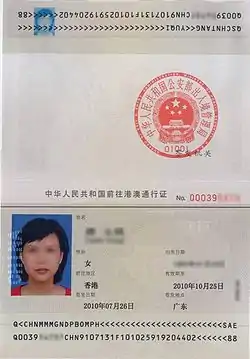People's Republic of China Permit for Proceeding to Hong Kong and Macao
A People's Republic of China Permit for Proceeding to Hong Kong and Macao, or One-way Permit, is a document issued by the People's Republic of China allowing residents of mainland China to leave the mainland permanently to settle in Hong Kong or Macau.[1]

| People's Republic of China Permit for Proceeding to Hong Kong and Macao | |||||||||||||
|---|---|---|---|---|---|---|---|---|---|---|---|---|---|
| Traditional Chinese | 中華人民共和國前往港澳通行證 | ||||||||||||
| Simplified Chinese | 中华人民共和国前往港澳通行证 | ||||||||||||
| |||||||||||||
| One-way Permit | |||||||||||||
| Traditional Chinese | 單程證 | ||||||||||||
| Simplified Chinese | 单程证 | ||||||||||||
| |||||||||||||
The scheme was introduced in 1980.[2] The travel restriction was needed to prevent large volumes of people coming to Hong Kong or Macau and preventing illegal immigration.[3]
Controversy
Although the permit is specifically for the purpose of family reunion, not for general immigration,[4] the scheme is controversial. Hong Kong currently has a quota of 150 people per day and the waiting time for spouses is currently 4 years.[5] Journalist Ching Cheong alleges that the scheme, whose beneficiaries are at the sole discretion of the PRC government and outside of the vetting procedures of the Hong Kong Immigration Department, is an infiltration mechanism by spies and friends of the regime into Hong Kong; those that are not filled by spies become a graft mechanism for officials.[6][7] Martin Lee said that the policy is part of the CPC's strategy of long-run "Tibetisation" of Hong Kong, aimed at marginalising Hong Kong people and their core values over time.[7][8]
Citizen rights
When settling to Hong Kong or Macau, the household registration in the mainland is relinquished, however, a person need to reside in the SAR for 7 years for the permanent resident status, which grants citizen rights. Therefore, before the person can acquire permanent resident status, he/she is effectively a second-class citizen in the SAR, without citizen rights (e.g. getting a passport) in both mainland China or the SAR.
Selected statistics on One-way Permit Holders (OWPHs)
| Year | No. of OWPHs | OWPHs aged 15+ | Remaining quota by year | Median age |
|---|---|---|---|---|
| 2002 | 45234 | 30945 | 9516 | 29 |
| 2003 | 53507 | 38640 | 1243 | 30 |
| 2004 | 38072 | 26752 | 16678 | 29 |
| 2005 | 55106 | 40568 | -356 | 29 |
| 2006 | 54170 | 37779 | 580 | 27 |
| 2007 | 33865 | 24798 | 20885 | 28 |
| 2008 | 41610 | 31435 | 13140 | 28 |
| 2009 | 48587 | 38854 | 6163 | 29 |
| 2010 | 42624 | 34071 | 1216 | 29 |
| 2011 | 43379 | 35916 | 11371 | 31 |
| 2012 | 54646 | 47721 | 254 | 36 |
| 2013 | 45031 | 37797 | 9719 | 33 |
| 2014 | 40496 | 32627 | 14254 | 32 |
| 2015 | 38338 | 31423 | 16412 | 32 |
| 2016 | 57387 | 47358 | -2492 | 32 |
| 2017 | 46971 | 38740 | 7779 | 32 |
| 2018 | 42331 | 35002 | 12569 | 33 |
| 2019 | 39060 | 31358 | 15690 | 32 |
| 2020 Q1 | 3223 | 2298 | - | 27 |
As of the end of 2016, approximately 950,000 mainland migrants came from the program, representing about 12.8% of Hong Kong's total population.[10]
See also
- Exit-Entry Permit for Travelling to and from Hong Kong and Macau: The permit issued to Mainland Chinese residents visiting Hong Kong and Macau temporary.
- Home Return Permit
- Taiwan Compatriot Entry Permit
References
- Press Releases — LCQ17: One-way Permit, Government Information Centre, Hong Kong.
- Hong Kong doctors join localist protest against one-way permit scheme, as mainland migrant influx blamed for stretched hospitals
- Arrangement for Entry to Hong Kong from Mainland China Archived 1 June 2008 at the Wayback Machine, Immigration Department, Hong Kong.
- "The Past and Future of the One Way Permit Scheme in the Context of a Population Policy for Hong Kong http://www.bauhinia.org/pdf/research/20080828/OWP_Report.pdf" (PDF). Archived from the original (PDF) on 28 October 2013. Retrieved 1 August 2013. External link in
|title=(help) - "LCQ2: One-way permit scheme". www.info.gov.hk. Retrieved 5 December 2019.
- 程翔, 從十八大看香港地下黨規模 Archived 24 February 2015 at the Wayback Machine. Sina Corporation. Ming Pao, 7 November 2012.
- Hung, Ho-fung. "Three Views of Local Consciousness in Hong Kong". The Asia-Pacific Journal, Vol. 12; Issue 44, No. 1; 3 November 2014.
- Lee, Martin (29 September 2012). "香港西藏化". Next Magazine.
- "Home Affairs Department - Public Services - Services for the New Arrivals from The Mainland - Questionnaire Survey". www.had.gov.hk. Retrieved 5 December 2019.
- "Number of mainlanders moving to Hong Kong drops by almost 15,000". South China Morning Post. 15 August 2018. Retrieved 2 September 2020.